Advance Financial Management: Corporate Governance and Banks Report
VerifiedAdded on 2022/10/04
|25
|5687
|22
Report
AI Summary
This report, titled 'Advance Financial Management,' delves into the realm of corporate governance, its principles, and the relevant laws and regulations. It begins with an executive summary and table of contents, providing a structured overview. The report explores key aspects of corporate governance, including shareholder recognition, stakeholder interests, board responsibilities, ethical behavior, and business transparency. It then examines the Corporation Act 2001, the roles of ASIC, and the regulatory framework in Australia. A significant portion of the report focuses on analyzing the corporate governance practices of the Australia and New Zealand Bank (ANZ) and the Commonwealth Bank, comparing their approaches to risk management, shareholder engagement, board responsibilities, and compliance with ASX and ASIC regulations. The report identifies areas of non-compliance and concludes with recommendations for improving corporate governance, ultimately aiming to enhance financial performance and protect stakeholder interests. The report concludes with a comprehensive list of references.

Running Head: ADVANCE FINANCIAL MANAGEMENT
Advance financial management
Name of the Student:
Name of the University:
Author note:
Advance financial management
Name of the Student:
Name of the University:
Author note:
Paraphrase This Document
Need a fresh take? Get an instant paraphrase of this document with our AI Paraphraser
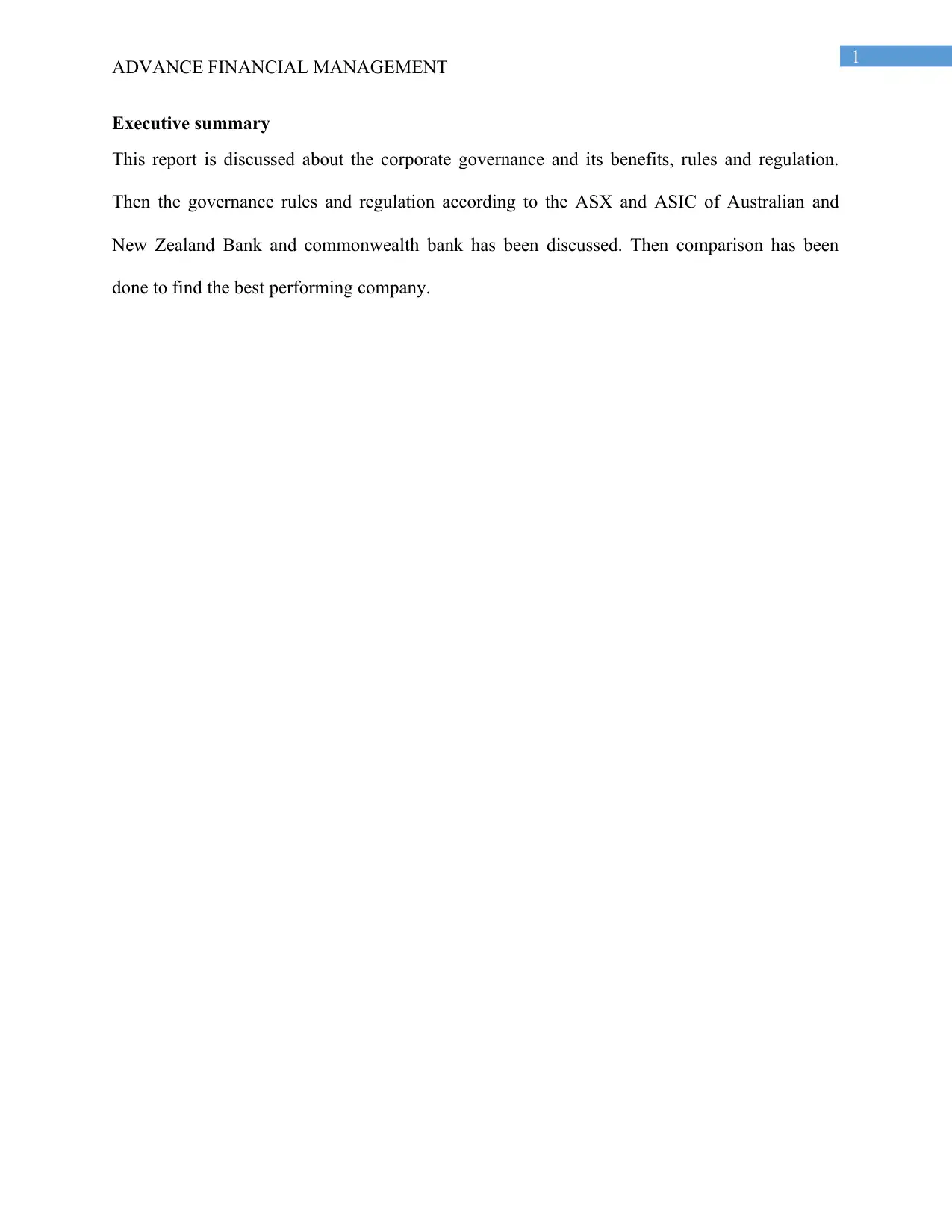
1
ADVANCE FINANCIAL MANAGEMENT
Executive summary
This report is discussed about the corporate governance and its benefits, rules and regulation.
Then the governance rules and regulation according to the ASX and ASIC of Australian and
New Zealand Bank and commonwealth bank has been discussed. Then comparison has been
done to find the best performing company.
ADVANCE FINANCIAL MANAGEMENT
Executive summary
This report is discussed about the corporate governance and its benefits, rules and regulation.
Then the governance rules and regulation according to the ASX and ASIC of Australian and
New Zealand Bank and commonwealth bank has been discussed. Then comparison has been
done to find the best performing company.
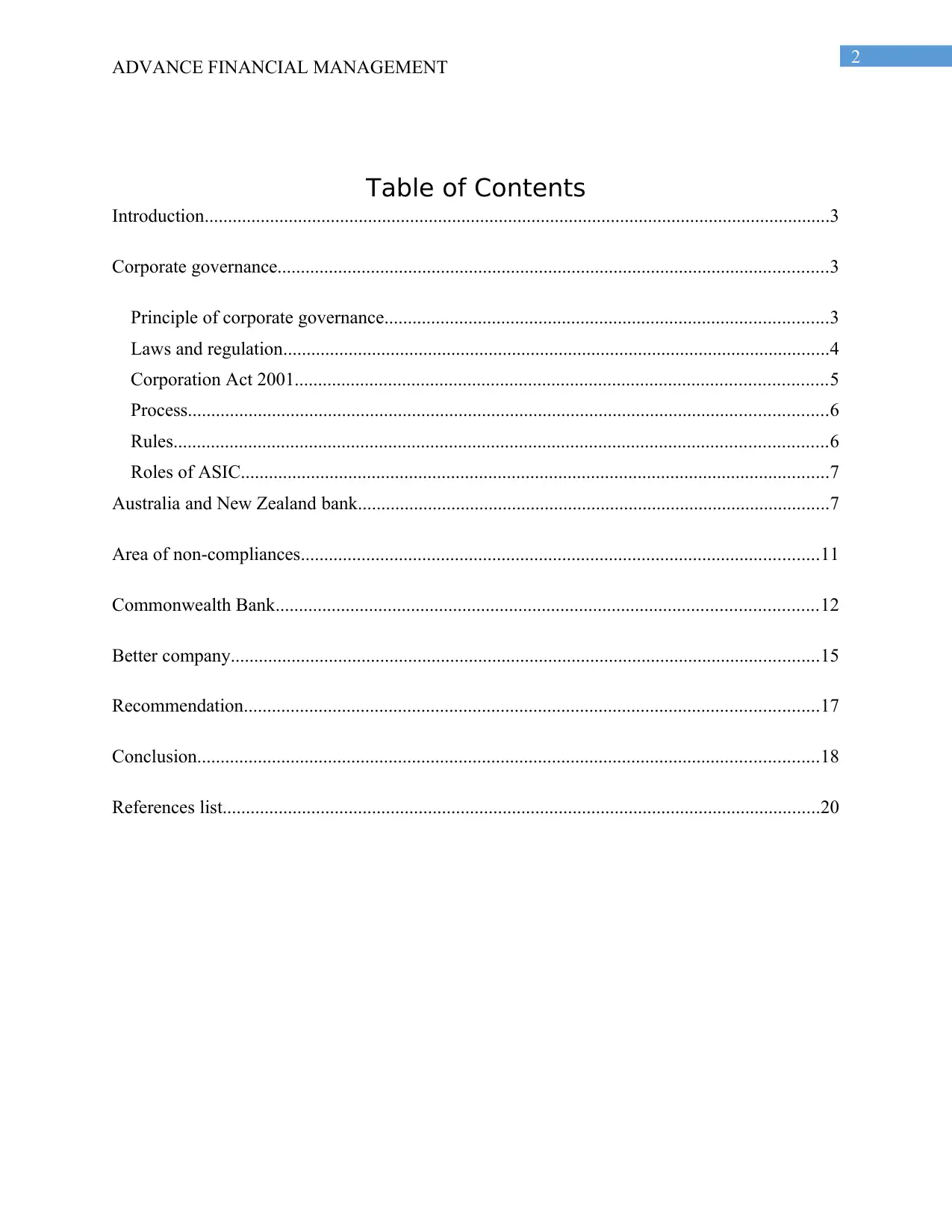
2
ADVANCE FINANCIAL MANAGEMENT
Table of Contents
Introduction......................................................................................................................................3
Corporate governance......................................................................................................................3
Principle of corporate governance...............................................................................................3
Laws and regulation.....................................................................................................................4
Corporation Act 2001..................................................................................................................5
Process.........................................................................................................................................6
Rules............................................................................................................................................6
Roles of ASIC..............................................................................................................................7
Australia and New Zealand bank.....................................................................................................7
Area of non-compliances...............................................................................................................11
Commonwealth Bank....................................................................................................................12
Better company..............................................................................................................................15
Recommendation...........................................................................................................................17
Conclusion.....................................................................................................................................18
References list................................................................................................................................20
ADVANCE FINANCIAL MANAGEMENT
Table of Contents
Introduction......................................................................................................................................3
Corporate governance......................................................................................................................3
Principle of corporate governance...............................................................................................3
Laws and regulation.....................................................................................................................4
Corporation Act 2001..................................................................................................................5
Process.........................................................................................................................................6
Rules............................................................................................................................................6
Roles of ASIC..............................................................................................................................7
Australia and New Zealand bank.....................................................................................................7
Area of non-compliances...............................................................................................................11
Commonwealth Bank....................................................................................................................12
Better company..............................................................................................................................15
Recommendation...........................................................................................................................17
Conclusion.....................................................................................................................................18
References list................................................................................................................................20
⊘ This is a preview!⊘
Do you want full access?
Subscribe today to unlock all pages.

Trusted by 1+ million students worldwide
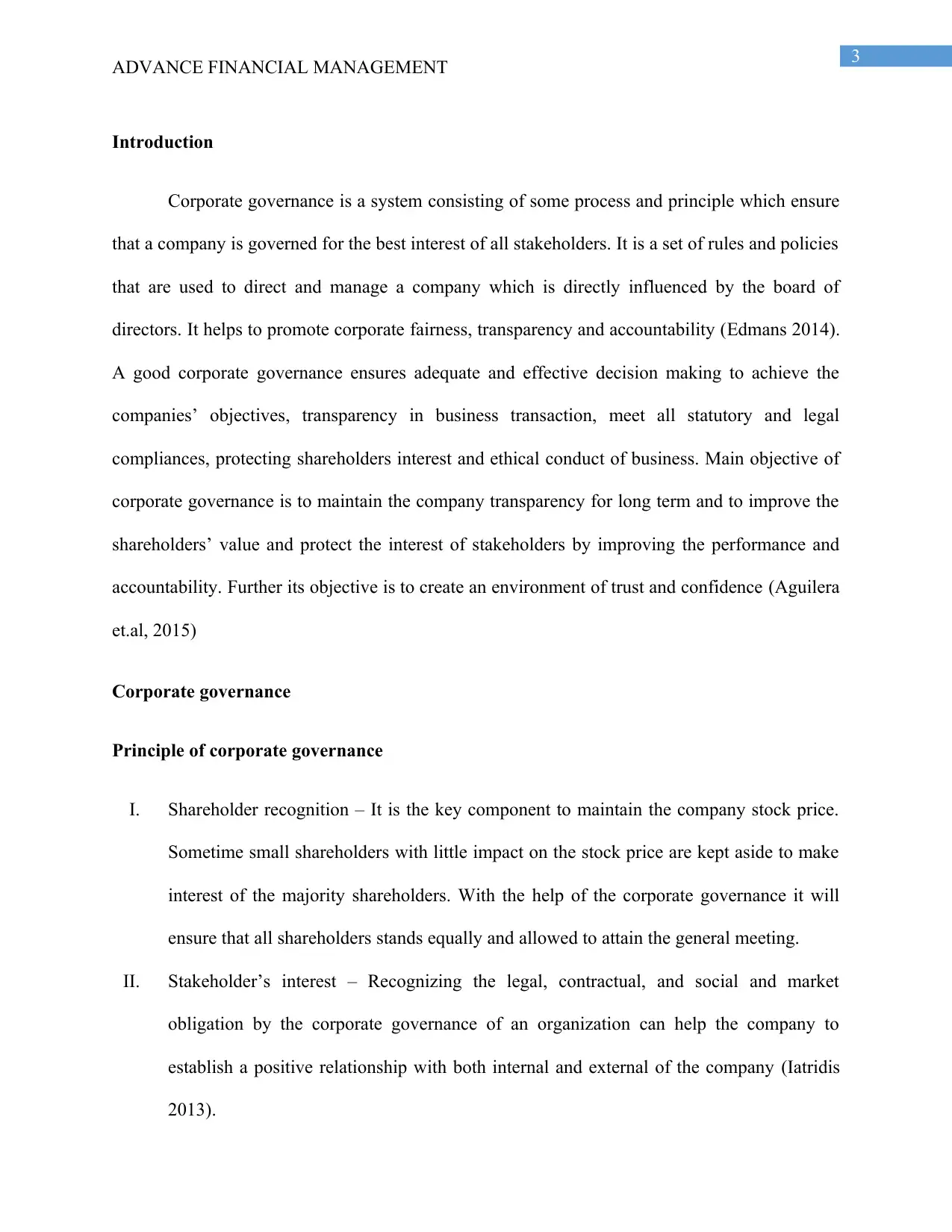
3
ADVANCE FINANCIAL MANAGEMENT
Introduction
Corporate governance is a system consisting of some process and principle which ensure
that a company is governed for the best interest of all stakeholders. It is a set of rules and policies
that are used to direct and manage a company which is directly influenced by the board of
directors. It helps to promote corporate fairness, transparency and accountability (Edmans 2014).
A good corporate governance ensures adequate and effective decision making to achieve the
companies’ objectives, transparency in business transaction, meet all statutory and legal
compliances, protecting shareholders interest and ethical conduct of business. Main objective of
corporate governance is to maintain the company transparency for long term and to improve the
shareholders’ value and protect the interest of stakeholders by improving the performance and
accountability. Further its objective is to create an environment of trust and confidence (Aguilera
et.al, 2015)
Corporate governance
Principle of corporate governance
I. Shareholder recognition – It is the key component to maintain the company stock price.
Sometime small shareholders with little impact on the stock price are kept aside to make
interest of the majority shareholders. With the help of the corporate governance it will
ensure that all shareholders stands equally and allowed to attain the general meeting.
II. Stakeholder’s interest – Recognizing the legal, contractual, and social and market
obligation by the corporate governance of an organization can help the company to
establish a positive relationship with both internal and external of the company (Iatridis
2013).
ADVANCE FINANCIAL MANAGEMENT
Introduction
Corporate governance is a system consisting of some process and principle which ensure
that a company is governed for the best interest of all stakeholders. It is a set of rules and policies
that are used to direct and manage a company which is directly influenced by the board of
directors. It helps to promote corporate fairness, transparency and accountability (Edmans 2014).
A good corporate governance ensures adequate and effective decision making to achieve the
companies’ objectives, transparency in business transaction, meet all statutory and legal
compliances, protecting shareholders interest and ethical conduct of business. Main objective of
corporate governance is to maintain the company transparency for long term and to improve the
shareholders’ value and protect the interest of stakeholders by improving the performance and
accountability. Further its objective is to create an environment of trust and confidence (Aguilera
et.al, 2015)
Corporate governance
Principle of corporate governance
I. Shareholder recognition – It is the key component to maintain the company stock price.
Sometime small shareholders with little impact on the stock price are kept aside to make
interest of the majority shareholders. With the help of the corporate governance it will
ensure that all shareholders stands equally and allowed to attain the general meeting.
II. Stakeholder’s interest – Recognizing the legal, contractual, and social and market
obligation by the corporate governance of an organization can help the company to
establish a positive relationship with both internal and external of the company (Iatridis
2013).
Paraphrase This Document
Need a fresh take? Get an instant paraphrase of this document with our AI Paraphraser
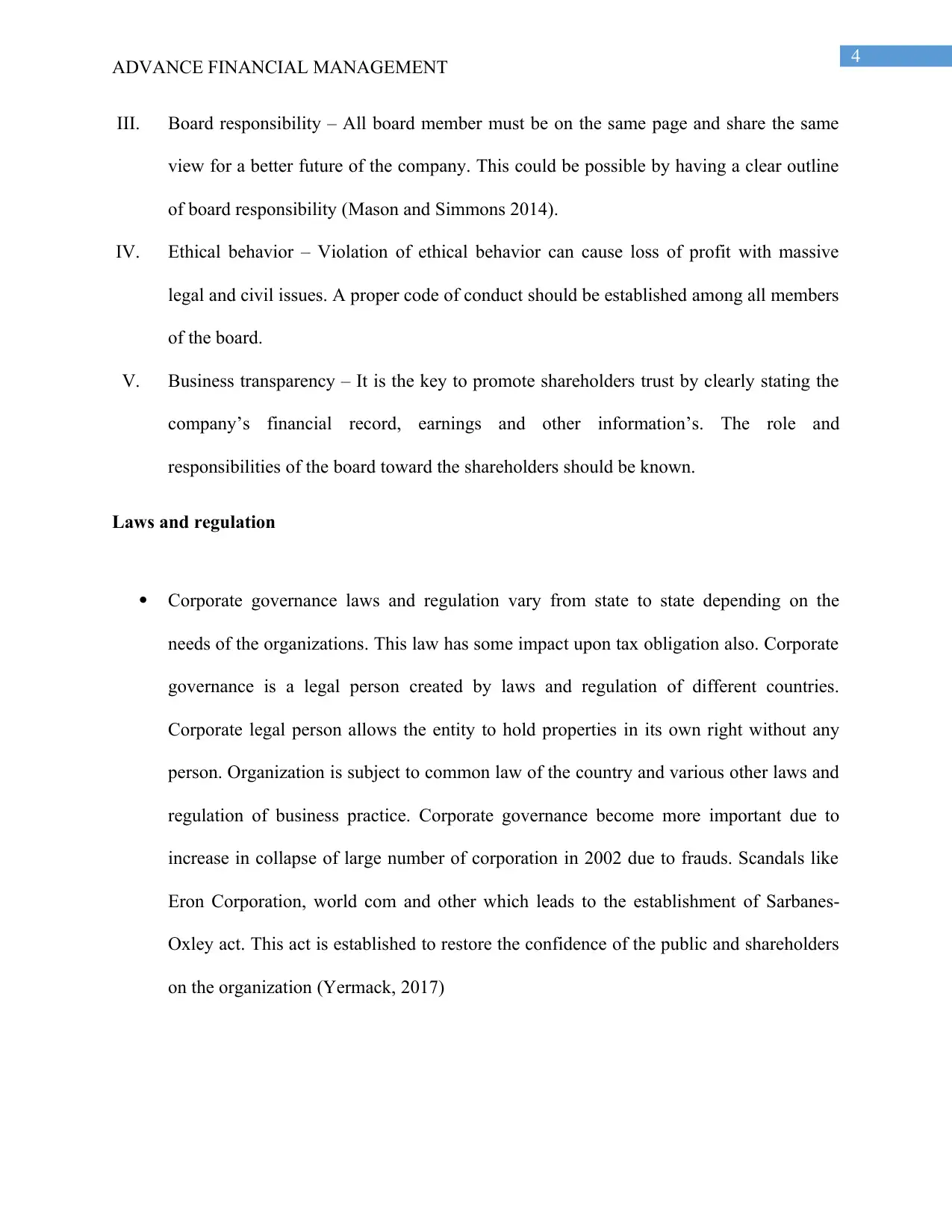
4
ADVANCE FINANCIAL MANAGEMENT
III. Board responsibility – All board member must be on the same page and share the same
view for a better future of the company. This could be possible by having a clear outline
of board responsibility (Mason and Simmons 2014).
IV. Ethical behavior – Violation of ethical behavior can cause loss of profit with massive
legal and civil issues. A proper code of conduct should be established among all members
of the board.
V. Business transparency – It is the key to promote shareholders trust by clearly stating the
company’s financial record, earnings and other information’s. The role and
responsibilities of the board toward the shareholders should be known.
Laws and regulation
Corporate governance laws and regulation vary from state to state depending on the
needs of the organizations. This law has some impact upon tax obligation also. Corporate
governance is a legal person created by laws and regulation of different countries.
Corporate legal person allows the entity to hold properties in its own right without any
person. Organization is subject to common law of the country and various other laws and
regulation of business practice. Corporate governance become more important due to
increase in collapse of large number of corporation in 2002 due to frauds. Scandals like
Eron Corporation, world com and other which leads to the establishment of Sarbanes-
Oxley act. This act is established to restore the confidence of the public and shareholders
on the organization (Yermack, 2017)
ADVANCE FINANCIAL MANAGEMENT
III. Board responsibility – All board member must be on the same page and share the same
view for a better future of the company. This could be possible by having a clear outline
of board responsibility (Mason and Simmons 2014).
IV. Ethical behavior – Violation of ethical behavior can cause loss of profit with massive
legal and civil issues. A proper code of conduct should be established among all members
of the board.
V. Business transparency – It is the key to promote shareholders trust by clearly stating the
company’s financial record, earnings and other information’s. The role and
responsibilities of the board toward the shareholders should be known.
Laws and regulation
Corporate governance laws and regulation vary from state to state depending on the
needs of the organizations. This law has some impact upon tax obligation also. Corporate
governance is a legal person created by laws and regulation of different countries.
Corporate legal person allows the entity to hold properties in its own right without any
person. Organization is subject to common law of the country and various other laws and
regulation of business practice. Corporate governance become more important due to
increase in collapse of large number of corporation in 2002 due to frauds. Scandals like
Eron Corporation, world com and other which leads to the establishment of Sarbanes-
Oxley act. This act is established to restore the confidence of the public and shareholders
on the organization (Yermack, 2017)
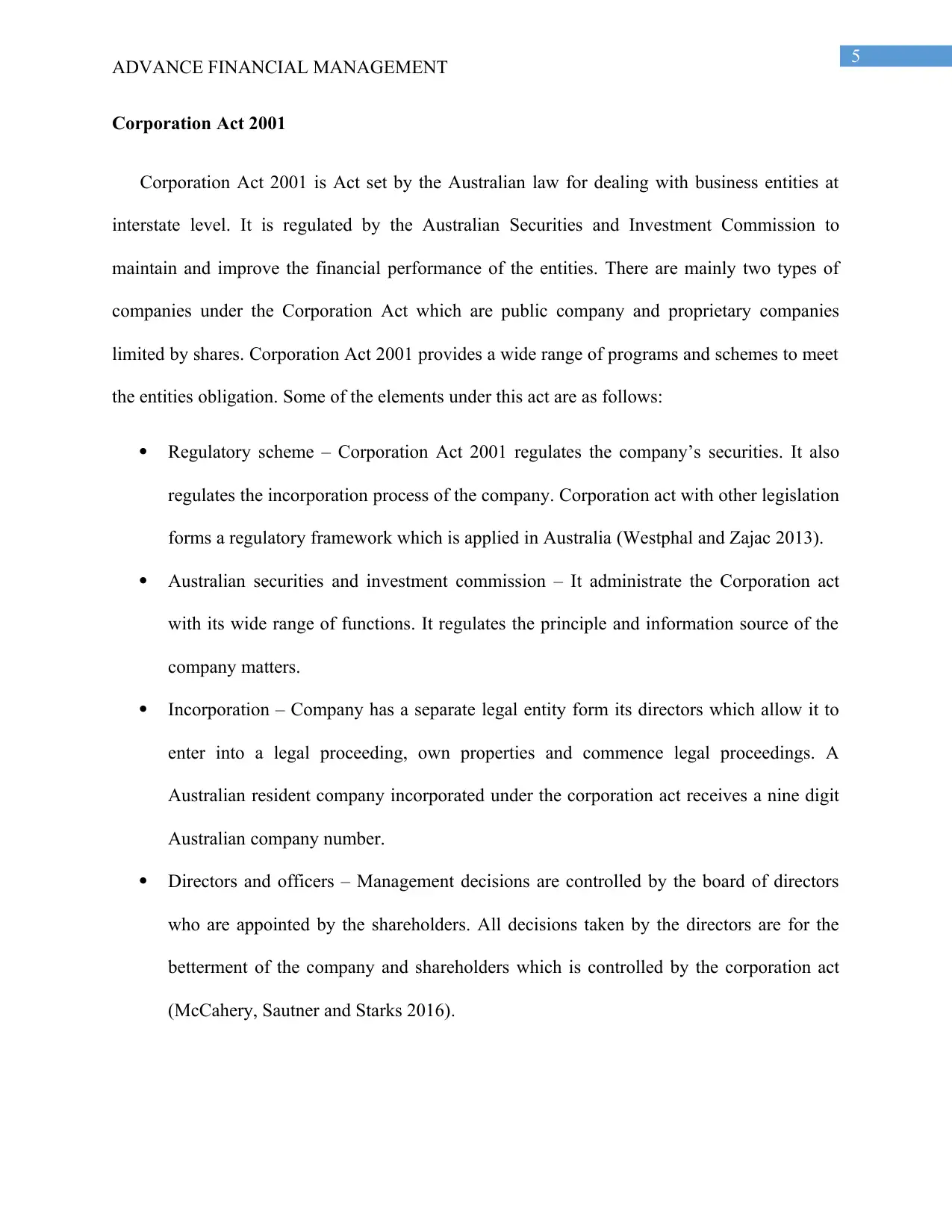
5
ADVANCE FINANCIAL MANAGEMENT
Corporation Act 2001
Corporation Act 2001 is Act set by the Australian law for dealing with business entities at
interstate level. It is regulated by the Australian Securities and Investment Commission to
maintain and improve the financial performance of the entities. There are mainly two types of
companies under the Corporation Act which are public company and proprietary companies
limited by shares. Corporation Act 2001 provides a wide range of programs and schemes to meet
the entities obligation. Some of the elements under this act are as follows:
Regulatory scheme – Corporation Act 2001 regulates the company’s securities. It also
regulates the incorporation process of the company. Corporation act with other legislation
forms a regulatory framework which is applied in Australia (Westphal and Zajac 2013).
Australian securities and investment commission – It administrate the Corporation act
with its wide range of functions. It regulates the principle and information source of the
company matters.
Incorporation – Company has a separate legal entity form its directors which allow it to
enter into a legal proceeding, own properties and commence legal proceedings. A
Australian resident company incorporated under the corporation act receives a nine digit
Australian company number.
Directors and officers – Management decisions are controlled by the board of directors
who are appointed by the shareholders. All decisions taken by the directors are for the
betterment of the company and shareholders which is controlled by the corporation act
(McCahery, Sautner and Starks 2016).
ADVANCE FINANCIAL MANAGEMENT
Corporation Act 2001
Corporation Act 2001 is Act set by the Australian law for dealing with business entities at
interstate level. It is regulated by the Australian Securities and Investment Commission to
maintain and improve the financial performance of the entities. There are mainly two types of
companies under the Corporation Act which are public company and proprietary companies
limited by shares. Corporation Act 2001 provides a wide range of programs and schemes to meet
the entities obligation. Some of the elements under this act are as follows:
Regulatory scheme – Corporation Act 2001 regulates the company’s securities. It also
regulates the incorporation process of the company. Corporation act with other legislation
forms a regulatory framework which is applied in Australia (Westphal and Zajac 2013).
Australian securities and investment commission – It administrate the Corporation act
with its wide range of functions. It regulates the principle and information source of the
company matters.
Incorporation – Company has a separate legal entity form its directors which allow it to
enter into a legal proceeding, own properties and commence legal proceedings. A
Australian resident company incorporated under the corporation act receives a nine digit
Australian company number.
Directors and officers – Management decisions are controlled by the board of directors
who are appointed by the shareholders. All decisions taken by the directors are for the
betterment of the company and shareholders which is controlled by the corporation act
(McCahery, Sautner and Starks 2016).
⊘ This is a preview!⊘
Do you want full access?
Subscribe today to unlock all pages.

Trusted by 1+ million students worldwide
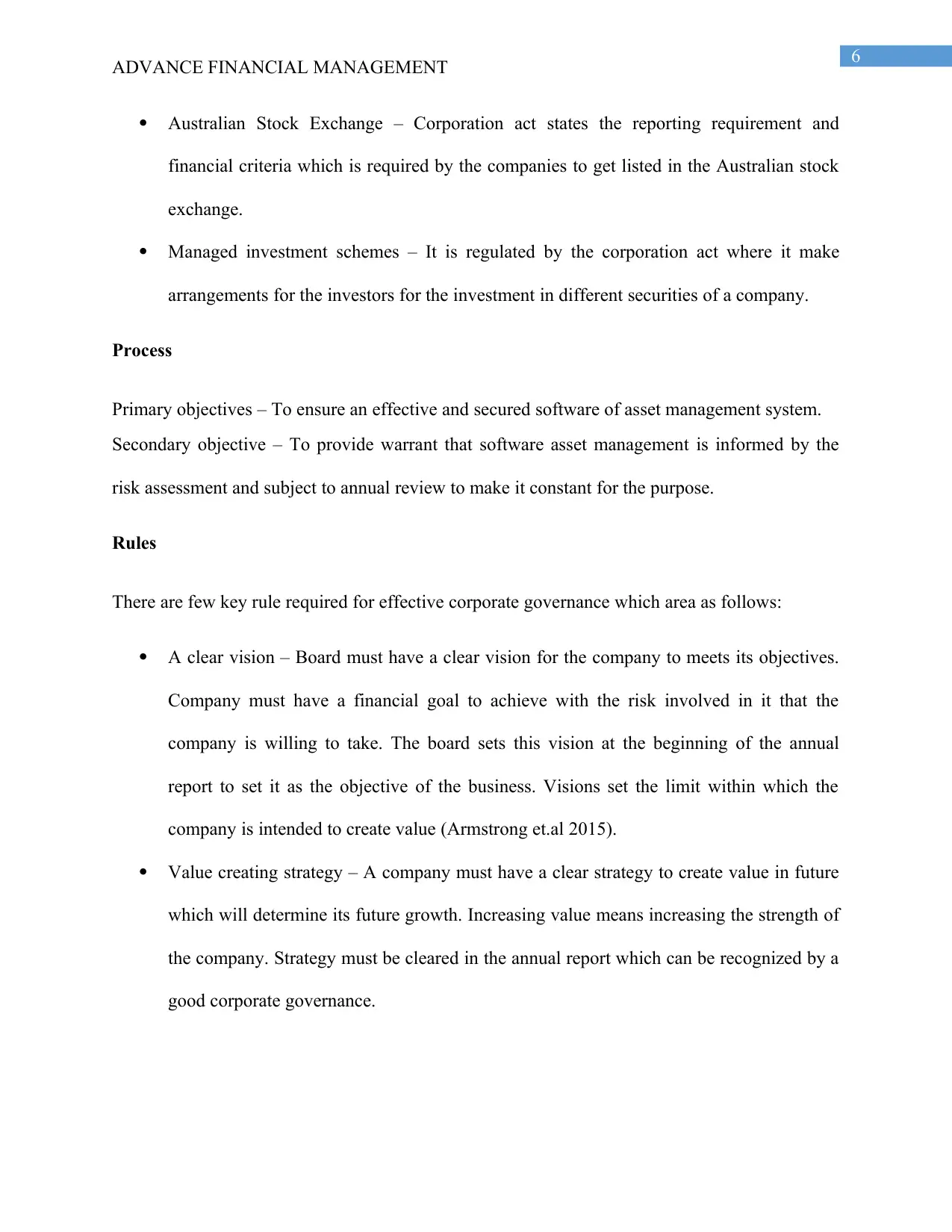
6
ADVANCE FINANCIAL MANAGEMENT
Australian Stock Exchange – Corporation act states the reporting requirement and
financial criteria which is required by the companies to get listed in the Australian stock
exchange.
Managed investment schemes – It is regulated by the corporation act where it make
arrangements for the investors for the investment in different securities of a company.
Process
Primary objectives – To ensure an effective and secured software of asset management system.
Secondary objective – To provide warrant that software asset management is informed by the
risk assessment and subject to annual review to make it constant for the purpose.
Rules
There are few key rule required for effective corporate governance which area as follows:
A clear vision – Board must have a clear vision for the company to meets its objectives.
Company must have a financial goal to achieve with the risk involved in it that the
company is willing to take. The board sets this vision at the beginning of the annual
report to set it as the objective of the business. Visions set the limit within which the
company is intended to create value (Armstrong et.al 2015).
Value creating strategy – A company must have a clear strategy to create value in future
which will determine its future growth. Increasing value means increasing the strength of
the company. Strategy must be cleared in the annual report which can be recognized by a
good corporate governance.
ADVANCE FINANCIAL MANAGEMENT
Australian Stock Exchange – Corporation act states the reporting requirement and
financial criteria which is required by the companies to get listed in the Australian stock
exchange.
Managed investment schemes – It is regulated by the corporation act where it make
arrangements for the investors for the investment in different securities of a company.
Process
Primary objectives – To ensure an effective and secured software of asset management system.
Secondary objective – To provide warrant that software asset management is informed by the
risk assessment and subject to annual review to make it constant for the purpose.
Rules
There are few key rule required for effective corporate governance which area as follows:
A clear vision – Board must have a clear vision for the company to meets its objectives.
Company must have a financial goal to achieve with the risk involved in it that the
company is willing to take. The board sets this vision at the beginning of the annual
report to set it as the objective of the business. Visions set the limit within which the
company is intended to create value (Armstrong et.al 2015).
Value creating strategy – A company must have a clear strategy to create value in future
which will determine its future growth. Increasing value means increasing the strength of
the company. Strategy must be cleared in the annual report which can be recognized by a
good corporate governance.
Paraphrase This Document
Need a fresh take? Get an instant paraphrase of this document with our AI Paraphraser
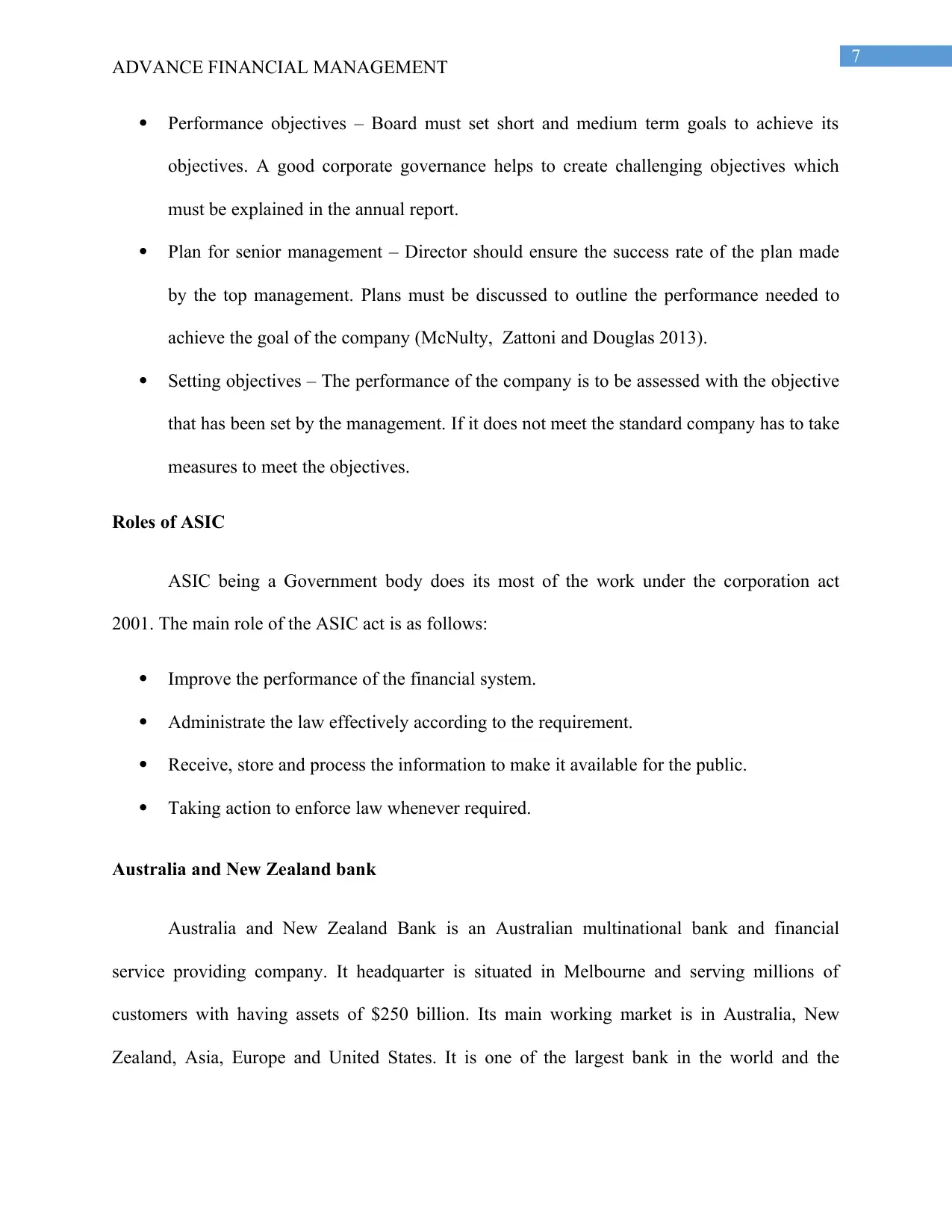
7
ADVANCE FINANCIAL MANAGEMENT
Performance objectives – Board must set short and medium term goals to achieve its
objectives. A good corporate governance helps to create challenging objectives which
must be explained in the annual report.
Plan for senior management – Director should ensure the success rate of the plan made
by the top management. Plans must be discussed to outline the performance needed to
achieve the goal of the company (McNulty, Zattoni and Douglas 2013).
Setting objectives – The performance of the company is to be assessed with the objective
that has been set by the management. If it does not meet the standard company has to take
measures to meet the objectives.
Roles of ASIC
ASIC being a Government body does its most of the work under the corporation act
2001. The main role of the ASIC act is as follows:
Improve the performance of the financial system.
Administrate the law effectively according to the requirement.
Receive, store and process the information to make it available for the public.
Taking action to enforce law whenever required.
Australia and New Zealand bank
Australia and New Zealand Bank is an Australian multinational bank and financial
service providing company. It headquarter is situated in Melbourne and serving millions of
customers with having assets of $250 billion. Its main working market is in Australia, New
Zealand, Asia, Europe and United States. It is one of the largest bank in the world and the
ADVANCE FINANCIAL MANAGEMENT
Performance objectives – Board must set short and medium term goals to achieve its
objectives. A good corporate governance helps to create challenging objectives which
must be explained in the annual report.
Plan for senior management – Director should ensure the success rate of the plan made
by the top management. Plans must be discussed to outline the performance needed to
achieve the goal of the company (McNulty, Zattoni and Douglas 2013).
Setting objectives – The performance of the company is to be assessed with the objective
that has been set by the management. If it does not meet the standard company has to take
measures to meet the objectives.
Roles of ASIC
ASIC being a Government body does its most of the work under the corporation act
2001. The main role of the ASIC act is as follows:
Improve the performance of the financial system.
Administrate the law effectively according to the requirement.
Receive, store and process the information to make it available for the public.
Taking action to enforce law whenever required.
Australia and New Zealand bank
Australia and New Zealand Bank is an Australian multinational bank and financial
service providing company. It headquarter is situated in Melbourne and serving millions of
customers with having assets of $250 billion. Its main working market is in Australia, New
Zealand, Asia, Europe and United States. It is one of the largest bank in the world and the
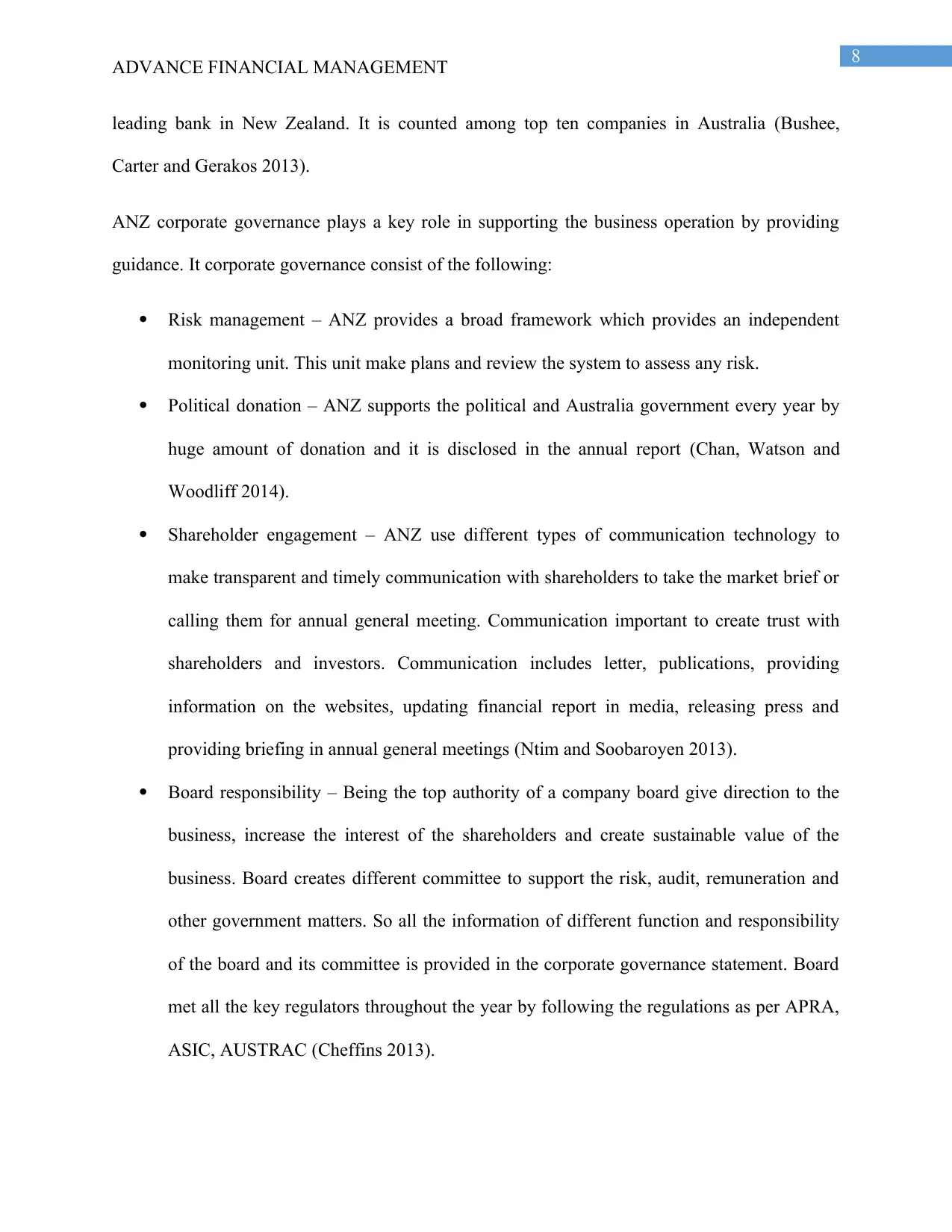
8
ADVANCE FINANCIAL MANAGEMENT
leading bank in New Zealand. It is counted among top ten companies in Australia (Bushee,
Carter and Gerakos 2013).
ANZ corporate governance plays a key role in supporting the business operation by providing
guidance. It corporate governance consist of the following:
Risk management – ANZ provides a broad framework which provides an independent
monitoring unit. This unit make plans and review the system to assess any risk.
Political donation – ANZ supports the political and Australia government every year by
huge amount of donation and it is disclosed in the annual report (Chan, Watson and
Woodliff 2014).
Shareholder engagement – ANZ use different types of communication technology to
make transparent and timely communication with shareholders to take the market brief or
calling them for annual general meeting. Communication important to create trust with
shareholders and investors. Communication includes letter, publications, providing
information on the websites, updating financial report in media, releasing press and
providing briefing in annual general meetings (Ntim and Soobaroyen 2013).
Board responsibility – Being the top authority of a company board give direction to the
business, increase the interest of the shareholders and create sustainable value of the
business. Board creates different committee to support the risk, audit, remuneration and
other government matters. So all the information of different function and responsibility
of the board and its committee is provided in the corporate governance statement. Board
met all the key regulators throughout the year by following the regulations as per APRA,
ASIC, AUSTRAC (Cheffins 2013).
ADVANCE FINANCIAL MANAGEMENT
leading bank in New Zealand. It is counted among top ten companies in Australia (Bushee,
Carter and Gerakos 2013).
ANZ corporate governance plays a key role in supporting the business operation by providing
guidance. It corporate governance consist of the following:
Risk management – ANZ provides a broad framework which provides an independent
monitoring unit. This unit make plans and review the system to assess any risk.
Political donation – ANZ supports the political and Australia government every year by
huge amount of donation and it is disclosed in the annual report (Chan, Watson and
Woodliff 2014).
Shareholder engagement – ANZ use different types of communication technology to
make transparent and timely communication with shareholders to take the market brief or
calling them for annual general meeting. Communication important to create trust with
shareholders and investors. Communication includes letter, publications, providing
information on the websites, updating financial report in media, releasing press and
providing briefing in annual general meetings (Ntim and Soobaroyen 2013).
Board responsibility – Being the top authority of a company board give direction to the
business, increase the interest of the shareholders and create sustainable value of the
business. Board creates different committee to support the risk, audit, remuneration and
other government matters. So all the information of different function and responsibility
of the board and its committee is provided in the corporate governance statement. Board
met all the key regulators throughout the year by following the regulations as per APRA,
ASIC, AUSTRAC (Cheffins 2013).
⊘ This is a preview!⊘
Do you want full access?
Subscribe today to unlock all pages.

Trusted by 1+ million students worldwide
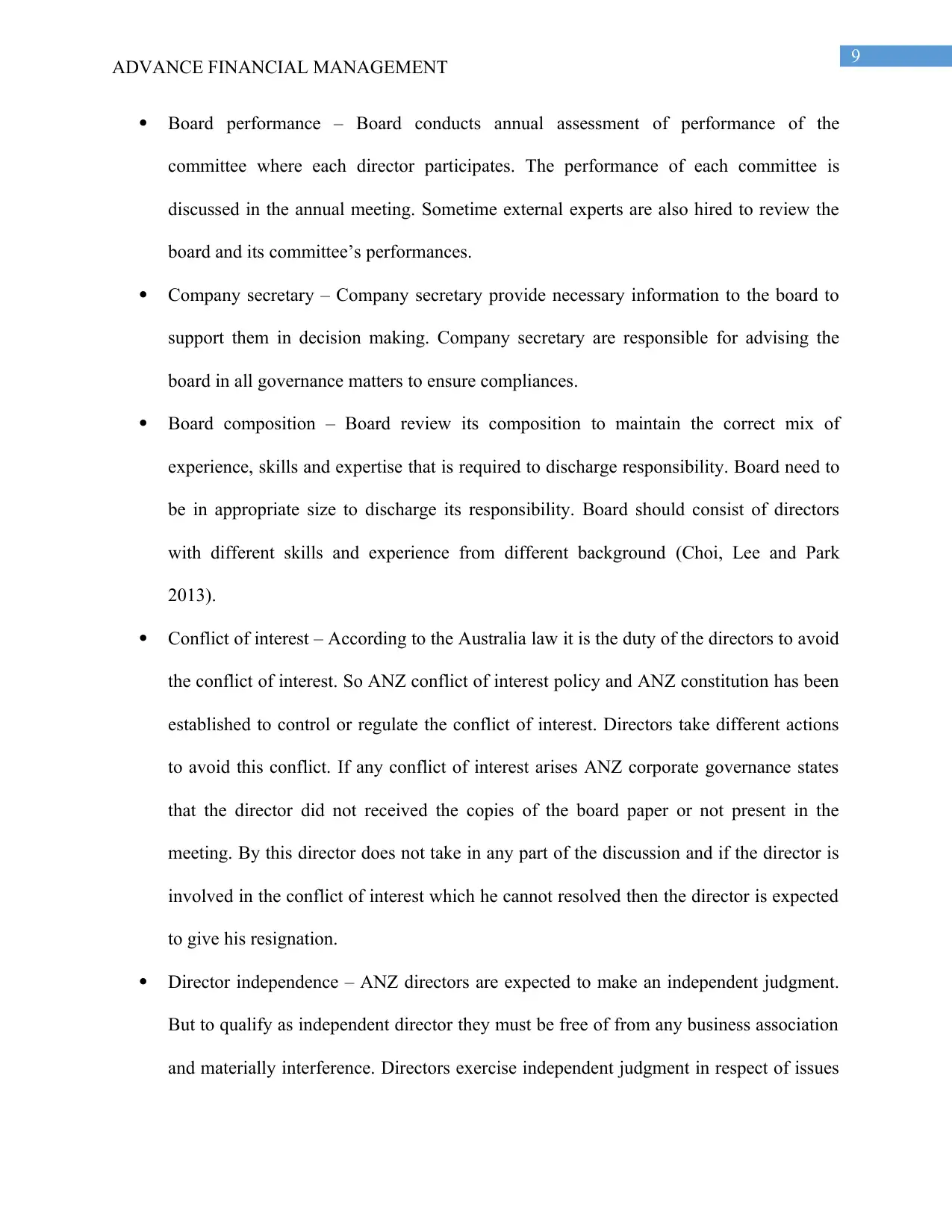
9
ADVANCE FINANCIAL MANAGEMENT
Board performance – Board conducts annual assessment of performance of the
committee where each director participates. The performance of each committee is
discussed in the annual meeting. Sometime external experts are also hired to review the
board and its committee’s performances.
Company secretary – Company secretary provide necessary information to the board to
support them in decision making. Company secretary are responsible for advising the
board in all governance matters to ensure compliances.
Board composition – Board review its composition to maintain the correct mix of
experience, skills and expertise that is required to discharge responsibility. Board need to
be in appropriate size to discharge its responsibility. Board should consist of directors
with different skills and experience from different background (Choi, Lee and Park
2013).
Conflict of interest – According to the Australia law it is the duty of the directors to avoid
the conflict of interest. So ANZ conflict of interest policy and ANZ constitution has been
established to control or regulate the conflict of interest. Directors take different actions
to avoid this conflict. If any conflict of interest arises ANZ corporate governance states
that the director did not received the copies of the board paper or not present in the
meeting. By this director does not take in any part of the discussion and if the director is
involved in the conflict of interest which he cannot resolved then the director is expected
to give his resignation.
Director independence – ANZ directors are expected to make an independent judgment.
But to qualify as independent director they must be free of from any business association
and materially interference. Directors exercise independent judgment in respect of issues
ADVANCE FINANCIAL MANAGEMENT
Board performance – Board conducts annual assessment of performance of the
committee where each director participates. The performance of each committee is
discussed in the annual meeting. Sometime external experts are also hired to review the
board and its committee’s performances.
Company secretary – Company secretary provide necessary information to the board to
support them in decision making. Company secretary are responsible for advising the
board in all governance matters to ensure compliances.
Board composition – Board review its composition to maintain the correct mix of
experience, skills and expertise that is required to discharge responsibility. Board need to
be in appropriate size to discharge its responsibility. Board should consist of directors
with different skills and experience from different background (Choi, Lee and Park
2013).
Conflict of interest – According to the Australia law it is the duty of the directors to avoid
the conflict of interest. So ANZ conflict of interest policy and ANZ constitution has been
established to control or regulate the conflict of interest. Directors take different actions
to avoid this conflict. If any conflict of interest arises ANZ corporate governance states
that the director did not received the copies of the board paper or not present in the
meeting. By this director does not take in any part of the discussion and if the director is
involved in the conflict of interest which he cannot resolved then the director is expected
to give his resignation.
Director independence – ANZ directors are expected to make an independent judgment.
But to qualify as independent director they must be free of from any business association
and materially interference. Directors exercise independent judgment in respect of issues
Paraphrase This Document
Need a fresh take? Get an instant paraphrase of this document with our AI Paraphraser
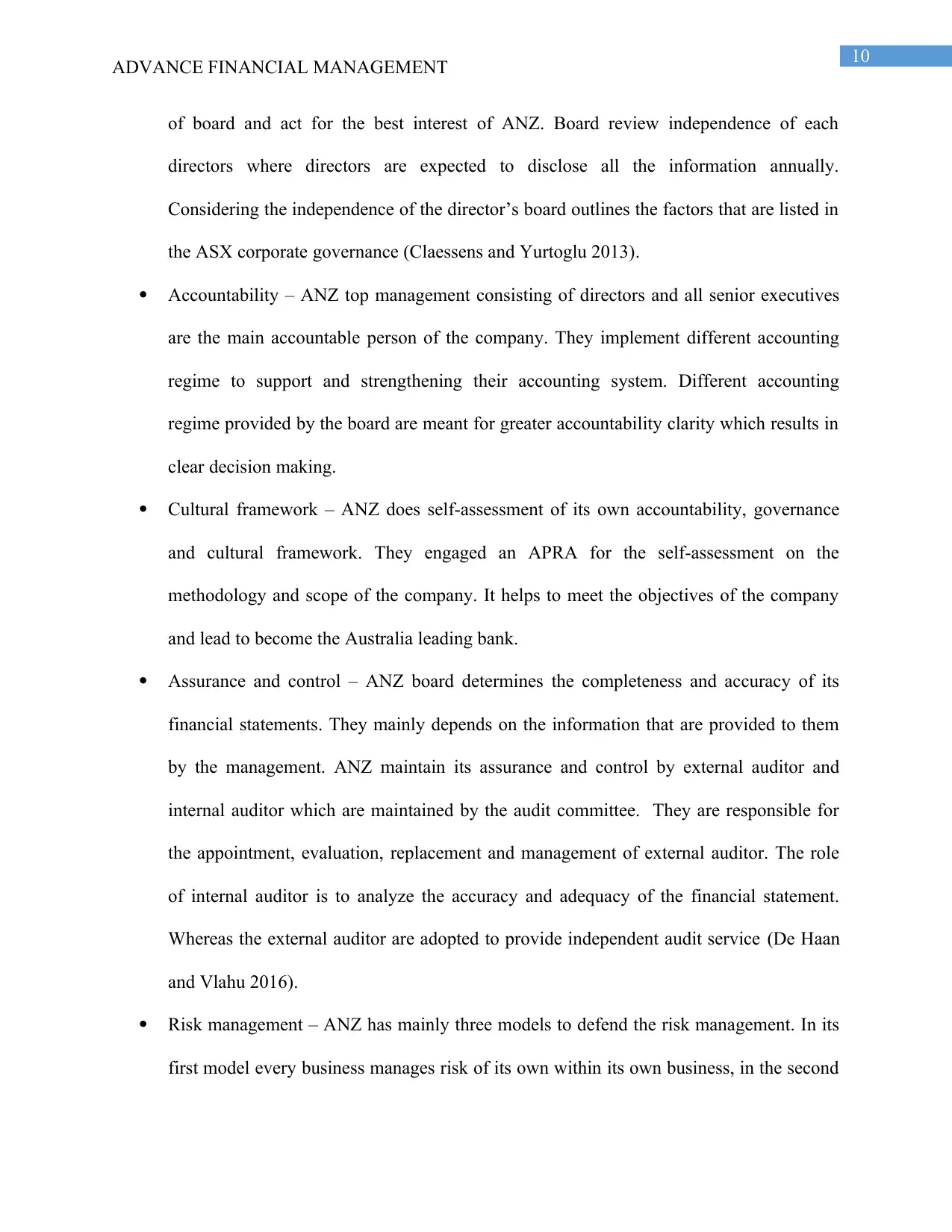
10
ADVANCE FINANCIAL MANAGEMENT
of board and act for the best interest of ANZ. Board review independence of each
directors where directors are expected to disclose all the information annually.
Considering the independence of the director’s board outlines the factors that are listed in
the ASX corporate governance (Claessens and Yurtoglu 2013).
Accountability – ANZ top management consisting of directors and all senior executives
are the main accountable person of the company. They implement different accounting
regime to support and strengthening their accounting system. Different accounting
regime provided by the board are meant for greater accountability clarity which results in
clear decision making.
Cultural framework – ANZ does self-assessment of its own accountability, governance
and cultural framework. They engaged an APRA for the self-assessment on the
methodology and scope of the company. It helps to meet the objectives of the company
and lead to become the Australia leading bank.
Assurance and control – ANZ board determines the completeness and accuracy of its
financial statements. They mainly depends on the information that are provided to them
by the management. ANZ maintain its assurance and control by external auditor and
internal auditor which are maintained by the audit committee. They are responsible for
the appointment, evaluation, replacement and management of external auditor. The role
of internal auditor is to analyze the accuracy and adequacy of the financial statement.
Whereas the external auditor are adopted to provide independent audit service (De Haan
and Vlahu 2016).
Risk management – ANZ has mainly three models to defend the risk management. In its
first model every business manages risk of its own within its own business, in the second
ADVANCE FINANCIAL MANAGEMENT
of board and act for the best interest of ANZ. Board review independence of each
directors where directors are expected to disclose all the information annually.
Considering the independence of the director’s board outlines the factors that are listed in
the ASX corporate governance (Claessens and Yurtoglu 2013).
Accountability – ANZ top management consisting of directors and all senior executives
are the main accountable person of the company. They implement different accounting
regime to support and strengthening their accounting system. Different accounting
regime provided by the board are meant for greater accountability clarity which results in
clear decision making.
Cultural framework – ANZ does self-assessment of its own accountability, governance
and cultural framework. They engaged an APRA for the self-assessment on the
methodology and scope of the company. It helps to meet the objectives of the company
and lead to become the Australia leading bank.
Assurance and control – ANZ board determines the completeness and accuracy of its
financial statements. They mainly depends on the information that are provided to them
by the management. ANZ maintain its assurance and control by external auditor and
internal auditor which are maintained by the audit committee. They are responsible for
the appointment, evaluation, replacement and management of external auditor. The role
of internal auditor is to analyze the accuracy and adequacy of the financial statement.
Whereas the external auditor are adopted to provide independent audit service (De Haan
and Vlahu 2016).
Risk management – ANZ has mainly three models to defend the risk management. In its
first model every business manages risk of its own within its own business, in the second
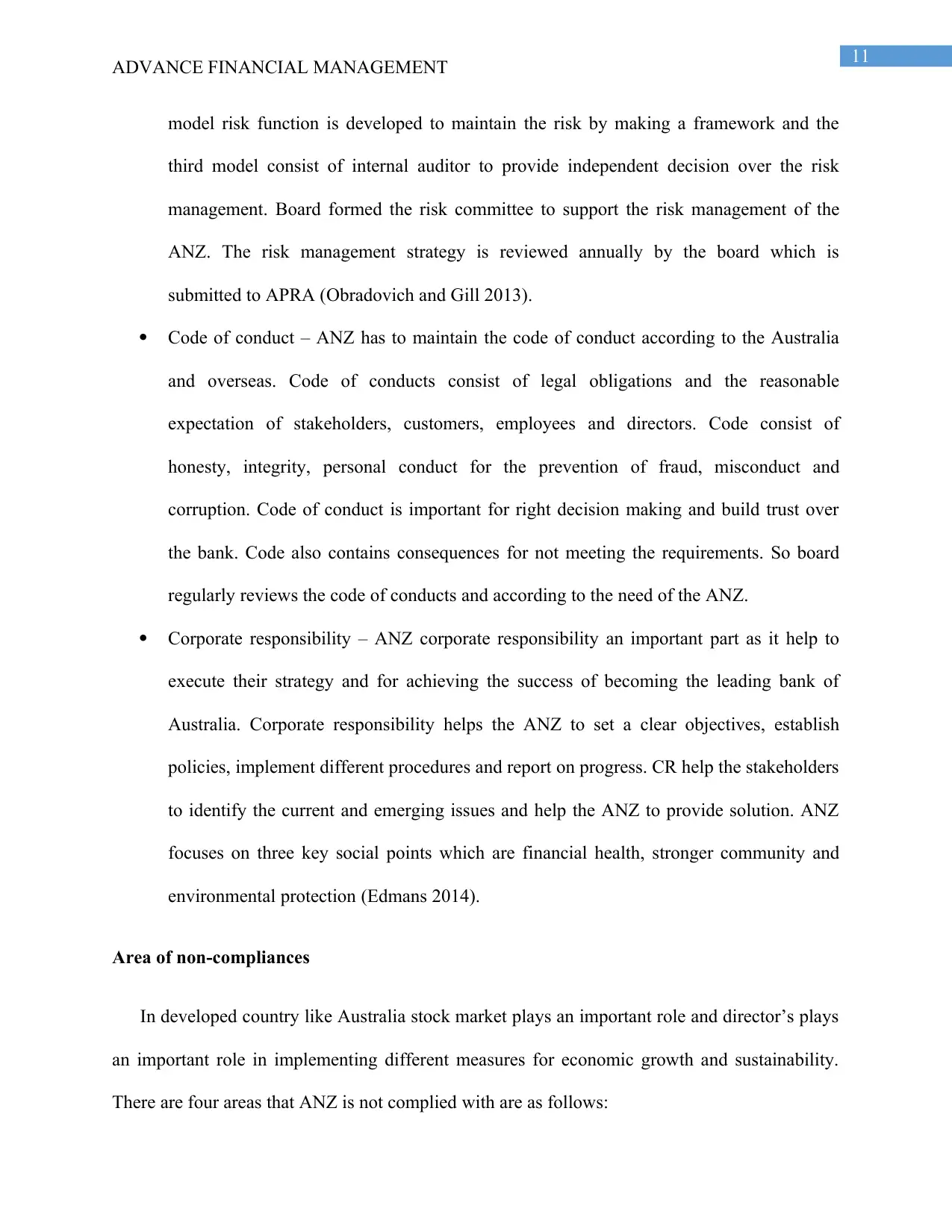
11
ADVANCE FINANCIAL MANAGEMENT
model risk function is developed to maintain the risk by making a framework and the
third model consist of internal auditor to provide independent decision over the risk
management. Board formed the risk committee to support the risk management of the
ANZ. The risk management strategy is reviewed annually by the board which is
submitted to APRA (Obradovich and Gill 2013).
Code of conduct – ANZ has to maintain the code of conduct according to the Australia
and overseas. Code of conducts consist of legal obligations and the reasonable
expectation of stakeholders, customers, employees and directors. Code consist of
honesty, integrity, personal conduct for the prevention of fraud, misconduct and
corruption. Code of conduct is important for right decision making and build trust over
the bank. Code also contains consequences for not meeting the requirements. So board
regularly reviews the code of conducts and according to the need of the ANZ.
Corporate responsibility – ANZ corporate responsibility an important part as it help to
execute their strategy and for achieving the success of becoming the leading bank of
Australia. Corporate responsibility helps the ANZ to set a clear objectives, establish
policies, implement different procedures and report on progress. CR help the stakeholders
to identify the current and emerging issues and help the ANZ to provide solution. ANZ
focuses on three key social points which are financial health, stronger community and
environmental protection (Edmans 2014).
Area of non-compliances
In developed country like Australia stock market plays an important role and director’s plays
an important role in implementing different measures for economic growth and sustainability.
There are four areas that ANZ is not complied with are as follows:
ADVANCE FINANCIAL MANAGEMENT
model risk function is developed to maintain the risk by making a framework and the
third model consist of internal auditor to provide independent decision over the risk
management. Board formed the risk committee to support the risk management of the
ANZ. The risk management strategy is reviewed annually by the board which is
submitted to APRA (Obradovich and Gill 2013).
Code of conduct – ANZ has to maintain the code of conduct according to the Australia
and overseas. Code of conducts consist of legal obligations and the reasonable
expectation of stakeholders, customers, employees and directors. Code consist of
honesty, integrity, personal conduct for the prevention of fraud, misconduct and
corruption. Code of conduct is important for right decision making and build trust over
the bank. Code also contains consequences for not meeting the requirements. So board
regularly reviews the code of conducts and according to the need of the ANZ.
Corporate responsibility – ANZ corporate responsibility an important part as it help to
execute their strategy and for achieving the success of becoming the leading bank of
Australia. Corporate responsibility helps the ANZ to set a clear objectives, establish
policies, implement different procedures and report on progress. CR help the stakeholders
to identify the current and emerging issues and help the ANZ to provide solution. ANZ
focuses on three key social points which are financial health, stronger community and
environmental protection (Edmans 2014).
Area of non-compliances
In developed country like Australia stock market plays an important role and director’s plays
an important role in implementing different measures for economic growth and sustainability.
There are four areas that ANZ is not complied with are as follows:
⊘ This is a preview!⊘
Do you want full access?
Subscribe today to unlock all pages.

Trusted by 1+ million students worldwide
1 out of 25
Related Documents
Your All-in-One AI-Powered Toolkit for Academic Success.
+13062052269
info@desklib.com
Available 24*7 on WhatsApp / Email
![[object Object]](/_next/static/media/star-bottom.7253800d.svg)
Unlock your academic potential
Copyright © 2020–2025 A2Z Services. All Rights Reserved. Developed and managed by ZUCOL.




